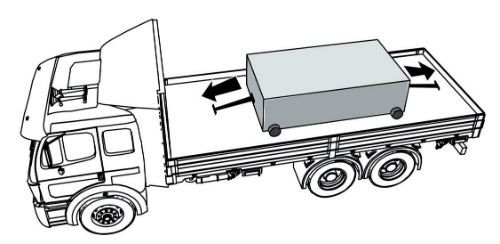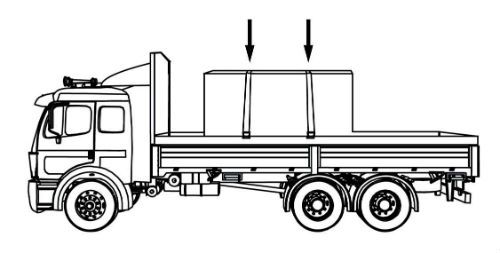CDL Practice Tests: Flatbed Cargo Securement
Choose A Section:
Go!When loaded cement pipe over 45 inches in diameter, which pipes should be blocked, wedged, or otherwise immobilized?
- It depends on the weight of the load.
- Rear only.
- Front and rear.
- Front only.
Immobilize the front and rear pipe with on of the following methods:
- Blocking
- Wedges
- Vehicle end structure
- Stakes
- Locked pipe unloader
- Other equivalent means
Which of the following is not a requirement of wood used as blocking or bracing?
- It should be properly seasoned.
- It should be free of decay and structural defects.
- Hardwood is recommended.
- It should be painted.
If wood is used:
- Hardwood is recommended.
- It should be properly seasoned.
- It should be free from rot or decay, knots, knotholes, and splits.
The maximum distance from the rear allowed for attaching mechanisms used to secure roll-on/roll-off containers is:
- 6 1/2 feet
- 2 feet
- It doesn't matter.
- 3 feet

Attach mechanisms used to secure the rear end of a roll-on/roll-off or hook lift container no more than two meters (6.5 feet) from the rear of the container.
What is the minimum Working Load Limit for the entire securement system?
- 100% of cargo weight.
- 80% of cargo weight.
- 20% of cargo weight.
- 50% of cargo weight.
Note: The minimum WLL requirement for the securement system is 50%. More tiedown capacity should be used if you need to secure an article against any movement.
As part of the log packing requirements:
- Each inside log on the side of a stack of logs must touch at least two bunks, bolsters, stakes, or standards.
- Outer bottom logs must be in contact with and rest solidly against bunks, bolsters, stakes, or standards.
- Logs must be loosely packed.
- The center of the highest log on each side or end must be above the top of each stake, bunk, or standard.
Packing requirements
- Logs must be solidly packed.
- Outer bottom logs must be in contact with and rest solidly against bunks, bolsters, stakes, or standards.
-
Each outside log on the side of a stack of logs must touch at least two bunks, bolsters, stakes, or standards. If one end of the log doesn't touch a stake:
- It must rest on other logs in a stable manner.
- It must extend beyond the stake, bunk, bolster, or standard.
- The center of the highest log on each side or end must be below the top of each stake, bunk, or standard.
When securing metal coils in a sided vehicle without anchor points:
- Follow general cargo securement requirements
- Use friction mats
- All of these apply
- Use locking and bracing
Securing Coils Transported in a Sided Vehicle or Intermodal Container without Anchor Points
To prevent metal coils from moving horizontally and/or tipping:
Follow general cargo securement requirements
Secure the coils using:
- Blocking and bracing
- Friction mats
- A combination of these.
In terms of cargo securement, what is a 'well'?
- The depression formed between two cylindrical articles when they are laid with their eyes horizontal and parallel against each other.
- A device placed between the deck of a vehicle and car or between articles of cargo, intended to provide greater friction than exists naturally between these surfaces.
- A rail along the side of a vehicle that protects the side of the vehicle from impacts.
- A female housing fixed to the side or ends of a vehicle to receive a stake or peg, and may also be used as an anchor point.
Well:
The depression formed between two cylindrical articles when they are laid with their eyes horizontal and parallel against each other.
When securing building materials, how many knots are acceptable in the tiedown(s)?
- 2
- 1
- Depends on the weight of the cargo.
- 0
Requirements for Securement System:
- In proper working order with no damaged or weakened components that affect their performance or reduce their working load limit.
- No knots.
- Attached and secured in a manner that prevents them from coming loose during transit.
- Able to be tightened by a driver of an in-transit vehicle.
- Located inboard of rub rails whenever practicable.
- Edge protection must be used when a tiedown would be subject to abrasion or cutting.
When securing concrete pipe loaded crosswise, arrange the top tier:
- Any of these are acceptable.
- As a complete tier.
- As a partial tier in one group.
- As a partial tier in two groups.
Requirements for arranging the top tier

Arrange the top tier as a complete tier, a partial tier in one group, or a partial tier in two groups.
The Aggregate Working Load Limit should, at minimum, be:
- 50% of the weight of the cargo.
- 100% of the weight of the cargo.
- Determined by the shipper.
- 80% of the weight of the cargo.
How much should the Aggregate Working Load Limit be?
The aggregate working load limit of any securement system must be at least 50% of the weight of the cargo being secured.
About The Flatbed Cargo Securement CDL Manual
Studying the flatbed cargo securement CDL manual is not a requirement for getting your CDL permit or license. It is required knowledge for flatbed drivers.
Some questions you should be able to answer for flatbed cargo securement:
- What is the minimum Working Load Limit of a tiedown used to secure logs?
- What is the minimum weight of a shipment of paper rolls that would require specific securement requirements?
- When securing concrete pipe over 45 inches loaded crosswise, which direction must the tiedowns on the front half of the load run?
- What is a cab shield?
- When securing concrete pipe over 45 inches loaded crosswise, which direction must the tiedowns on the rear half of the load run?
- What is a dunnage bag?
- Who is responsible for inspecting securing devices and cargo within the first 50 miles?
- How many tiedowns are required on a stack of shortwood loaded crosswise?
- What is the minimum working load limit of each tiedown used to secure crushed or flattened vehicles?
- Define 'bolster'
- What is a hook-lift container?
- When a tiedown is attached directly to the cargo, what is the ideal angle where it attached to the vehicle?
What is a securing device?
Any device specifically manufactured to attach or secure cargo to a vehicle or trailer:
- Synthetic Webbing
- Chain
- Wire rope
- Manila rope
- Synthetic rope
- Steel strapping
- Clamps and latches
- Blocking
- Front-end structure
- Grab hooks
- Binders
- Shackles
- Winches
- Stake pockets
- D-rings
- Webbing ratchet
- Bracing
- Friction mat
What is a tiedown?
A combination of securing devices that forms an assembly that:
- Attaches cargo to, or restrains cargo on a vehicle.
- Is attached to anchor point(s).

Some tiedowns are attached to the cargo and provide direct resistance to restrain the cargo from movement.

Some tie-downs pass over or through the cargo. They create a downward force that increases the effect of friction between the cargo and the deck. This friction restrains the cargo.
 Related Cargo Securement Terms That Every Driver Should Know:
Related Cargo Securement Terms That Every Driver Should Know:
-
Tiedown:
A combination of securing devices which form an assembly that attaches cargo to, or restrains cargo on, a vehicle or trailer, and is attached to anchor point(s).
-
Contained:
Cargo is contained if it fills a sided vehicle, and every article is in contact with or sufficiently close to a wall or other articles so that it cannot shift or tip if those other articles are also unable to shift or tip.
-
Blocking:
A structure, device, or another substantial article placed against or around an article to prevent horizontal movement of the article.
How should tiedowns be attached?
Tiedowns can be used in two ways:
-
Attached to the cargo:
- Tiedowns attached to the vehicle and attached to the cargo.
- Tiedowns attached to the vehicle, pass through or aroundan article of cargo, and then are attached to the vehicle again.
-
Pass over the cargo:
- Tiedowns attached to the vehicle, passed over the cargo, and then attached to the vehicle again.
Tiedown placement:

Place the tiedown as close as possible to the spacer.
Position the tiedowns as symetrically as possible over the length of the article.

Position the tiedowns to preserve the integrity of the article.







 TT On Facebook
TT On Facebook